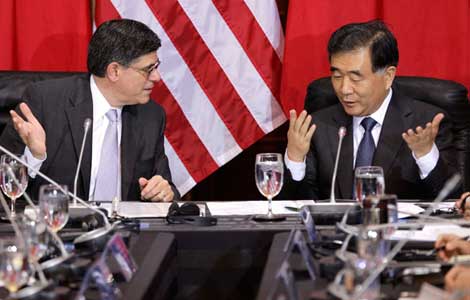Two-way fluctuation expectation shows RMB more market-oriented
Updated: 2013-07-12 11:06
(Xinhua)
|
||||||||
WASHINGTON - The two-way fluctuation expectation of renminbi exchange rate indicated that the Chinese currency had become more market-oriented, a senior Chinese central bank official said on Thursday.
"There are two-way fluctuation expectations of renminbi exchange rate in the recent spot and forward exchange rate markets," Yi Gang, deputy governor of the People's Bank of China, told a press briefing at the fifth round of the China-US Strategic and Economic Dialogue (S&ED).
This new trend indicated that the Chinese currency became more market-oriented as there had been a unilateral appreciation expectation of its exchange rate for a long time, he added.
Yi told reporters that the value of renminbi against US dollar had nominally appreciated by 2 percent since the beginning of this year, and the renminbi real effective exchange rate (REER) had increased by about 6 percent at the same period, highlighting a substantial progress toward the market-oriented currency exchange rate reform.
The central bank official stressed that China would continue to promote the renminbi exchange rate reform and make progress in the capital account convertibility.
As a very important feature of such reform, the supply-and-demand relation in the market will play a more important role in deciding the exchange rate of renminbi, he added.
Yi also said that China was fully prepared to tackle the challenge, such as capital outflows, amid prospects of US Federal Reserve's withdrawal of quantitative easing later this year.
He noted that China had abundant liquidity buffer with a high reserve requirement ratio, and would maintain prudent monetary policy to provide appropriate liquidity for Chinese money markets.
US Federal Reserve Chairman Ben Bernanke said last month the central bank could start scaling back its $85 billion monthly bond purchasing program later this year, if the economy continued to progress as the Fed expected.
The tapering plan has caused investors to withdraw money from emerging markets and restructure their portfolios, stoking volatility in currency, bond and equity markets around the globe.
Most Viewed
Editor's Picks

|

|

|

|

|

|
Today's Top News
More Americans favor immigration: Gallup
Constructive mood at Sino-US talks
China, Russia consider increasing naval drills
2 pilots called for Asiana to abort landing
Increased cooperation brings benefits
Japanese defense report lashed out
Lifesaving top priority, premier says
China's astronauts ready for challenge
US Weekly

|

|














